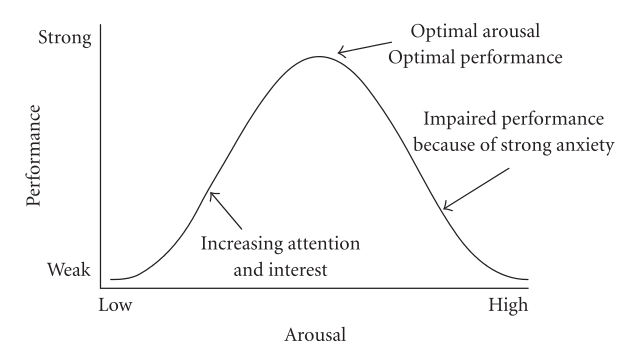Top Qs
Timeline
Chat
Perspective
Somatic anxiety
Physical manifestation of anxiety From Wikipedia, the free encyclopedia
Remove ads
Somatic anxiety, also known as somatization, is the physical manifestation of anxiety.[1] It is commonly contrasted with cognitive anxiety, which is the mental manifestation of anxiety, or the specific thought processes that occur during anxiety, such as concern or worry. These components of anxiety are especially studied in sports psychology,[2] specifically relating to how the anxiety symptoms affect athletic performance.
Associated symptoms typically include "abdominal pain, dyspepsia, chest pain, fatigue, dizziness, insomnia, and headache".[1] These symptoms can happen either alone or in a cluster.
Research on somatic anxiety is increasing.[3] Studies have reported that some medically overlooked cases that could not relate physical pain to any type of organ dysfunction typically could have been somatic anxiety.[1]
Remove ads
Anxiety-performance relationship theories
Summarize
Perspective
Drive theory
The Drive Theory[4] suggests that if an athlete is both skilled and driven (by somatic and cognitive anxiety) then the athlete will perform well.[5]
Inverted-U hypothesis

The Inverted-U Hypothesis,[6] also known as the Yerkes-Dodson law[6] hypothesizes that as somatic and cognitive anxiety (l) increase, performance increases until a threshold is crossed. Should arousal increase further, performance decreases.[5]
Multi-dimensional theory
The Multi-dimensional Theory of Anxiety[7] is based on the distinction between somatic and cognitive anxiety. The theory predicts that a negative, linear relationship between somatic and cognitive anxiety, an Inverted-U relationship between somatic anxiety and performance, and that somatic anxiety declines once performance begins although cognitive anxiety may remain high, if confidence is low.[8]
Catastrophe theory
Catastrophe Theory[9] suggests that stress, combined with both somatic and cognitive anxiety, influences performance, that somatic anxiety affects each athlete and each performance differently, limiting the ability to predict an outcome using general rules.[8]
Optimum arousal theory
Optimum Arousal Theory[10] states that each athlete performs best if their anxiety Alevel falls within an "optimum functioning zone".[5]
Remove ads
See also
References
Additional references
Wikiwand - on
Seamless Wikipedia browsing. On steroids.
Remove ads